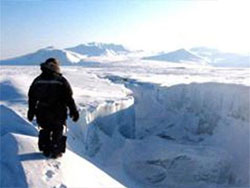Two floating islands leave the North Pole
Two large icebergs, about 4-5km2 and one 14km2, have separated from the ice block in the extreme Canada. On July 29, Canadian scientists confirmed that the two "floating islands" separated the large ice block at Ward Hunt Island.

A Canadian climate expert observes the ice separating the permafrost - Photo: AFP
This is the largest iceberg since 2005, when an ice sheet of 64.5 km 2 separated the adjacent Ayles ice block. The scientists also identified many deep cracks in the Ward Hunt ice island, which covers an area of about 401 square kilometers, and is one of five blocks along Ellesmere Island in Canada's northernmost region.
Climate experts say temperatures in many Arctic regions rise faster than the average temperature of the Earth over the past few decades, making ice blocks vulnerable to many icebergs, and will affect traffic. on the sea as well as causing sea level rise.
According to Globe And Mail, in the 20th century more than 23,300 square kilometers of Arctic ice sheets had reduced their area significantly, leaving only 2,590 square kilometers.
- The pole from the North of the Earth is ... shifting
- The north pole from the Earth is moving
- The pole from the North is moving to Russia
- How does the compass tell us where the North pole is at the South Pole?
- Video: Earth has 3 north poles
- Maldives is about to build a series of artificial floating islands
- The winter is prolonged due to the North Pole spiral moving
- Floating islands - solutions for living space in the future
- Canada started drawing seabed maps around the North Pole
- Why did the North Pole move toward London?
- Marvel at unexpected discoveries about the North Pole
- Amazingly huge ants fire floating in the super typhoon in America
 Is the magnetic North Pole shift dangerous to humanity?
Is the magnetic North Pole shift dangerous to humanity? Washington legalizes the recycling of human bodies into fertilizer
Washington legalizes the recycling of human bodies into fertilizer Lightning stone - the mysterious guest
Lightning stone - the mysterious guest Stunned by the mysterious sunset, strange appearance
Stunned by the mysterious sunset, strange appearance